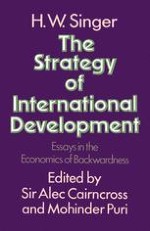1975 | OriginalPaper | Chapter
Some Problems of International Aid
Author : H. W. Singer
Published in: The Strategy of International Development
Publisher: Palgrave Macmillan UK
Included in: Professional Book Archive
Activate our intelligent search to find suitable subject content or patents.
Select sections of text to find matching patents with Artificial Intelligence. powered by
Select sections of text to find additional relevant content using AI-assisted search. powered by
The best-known volume target is the 1 per cent of national income adopted by the United Nations and accepted, at least in principle, by all the aid-giving countries. Such a target raises a number of obvious questions. In the first place, it obviously would be a minimum target. It is equally obvious that it requires some definition of ‘aid’ to be of any meaning. Should private investment be included? Short-term credits? Suppliers’ credits? Should grants and loans be equally counted? Should any distinction be made between the flow of aid and financial resources? If so, where should the line be drawn? Should aid be counted as gross, or as net of repayment? If the latter, what repayments should be taken into account? Should trade concessions be counted as aid? Should trade, tourism, etc., be disregarded when comparing the aid performance of countries? If commercial transactions such as private investments are not excluded, on what grounds can we distinguish between trade and aid? Should aid be measured as the cost to the donor or the value to the recipients — by no means identical concepts? The logic of meeting the need for such further definitions and precisions has been unmistakably at work in OECD discussions following upon the acceptance of the 1 per cent target.
